 Here is the final illustration of the assignment 2. As it must go with a title for the illustration, I name it as "The Floating Iceberg". Now let me write a little description about my illustration, well, I get the concept of creating illustration as it is part of effect by the melting ice cap. When the ice cap melt, part of the ice will break up and become a floating iceberg at the sea. Therefore, I choose to create this illustration to create awareness to people to realise of the effect by the melting ice cap.
Here is the final illustration of the assignment 2. As it must go with a title for the illustration, I name it as "The Floating Iceberg". Now let me write a little description about my illustration, well, I get the concept of creating illustration as it is part of effect by the melting ice cap. When the ice cap melt, part of the ice will break up and become a floating iceberg at the sea. Therefore, I choose to create this illustration to create awareness to people to realise of the effect by the melting ice cap.
Saturday, August 16, 2008
Final for Assignment 2!!!
 Here is the final illustration of the assignment 2. As it must go with a title for the illustration, I name it as "The Floating Iceberg". Now let me write a little description about my illustration, well, I get the concept of creating illustration as it is part of effect by the melting ice cap. When the ice cap melt, part of the ice will break up and become a floating iceberg at the sea. Therefore, I choose to create this illustration to create awareness to people to realise of the effect by the melting ice cap.
Here is the final illustration of the assignment 2. As it must go with a title for the illustration, I name it as "The Floating Iceberg". Now let me write a little description about my illustration, well, I get the concept of creating illustration as it is part of effect by the melting ice cap. When the ice cap melt, part of the ice will break up and become a floating iceberg at the sea. Therefore, I choose to create this illustration to create awareness to people to realise of the effect by the melting ice cap.
Procedures for the assignment 2
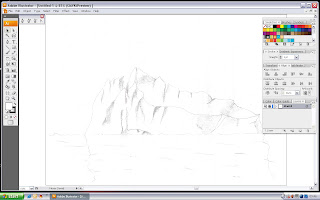 I import the sketch file to the illustrator. Then, I resize it to the same size as the A3 by clicking the Free Transform Tool and by holding down the shift key and pulling the corner anchor point to enlarge it accordingly without the change of shape.I set the sketch into a template file and set the layer name into sketch by double click the layer file.
I import the sketch file to the illustrator. Then, I resize it to the same size as the A3 by clicking the Free Transform Tool and by holding down the shift key and pulling the corner anchor point to enlarge it accordingly without the change of shape.I set the sketch into a template file and set the layer name into sketch by double click the layer file.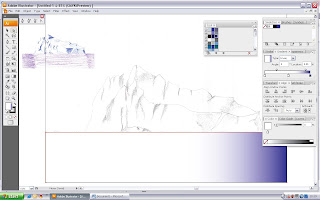
Then, I create a new layer with the replacement name to Sea with the same way by double click the layer file. Since the sea level is like border line between the iceberg and the sea. So, I will start off with illustrating the sea first but before I do so, I import the sketch with colour apply on it to used it as reference. Now to illustrate the sea, I draw a straight line with the pen tool and intersect around the below border. Then, I apply the gradient to it. In order to apply the gradient correctly white in between the blue. I click on the gradient panel and move the white pointer to the middle. After that, I add on another pointer to it. To apply colour, I go to the swatches panel and browse the swatches library and choose the colour properties that lead to the cool. From there I choose my colour for the sea and apply the change of name to it as sea.

With chosen colour swatches, I move it to the left white pointer. End up, white colour in between the blue. As the gradient colour is not correctly place between the iceberg and the sea, I drag the gradient slider to the point that suit my illustrator.
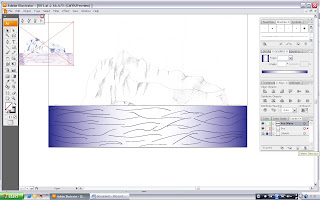
What made a sea without wave? So, I create a new layer with the name of sea wave. Then, I used the pen tool to draw line on the sea and exchange the stroke colour to deep colour blue. With the repeat procedures. I manage to create a sea wave.
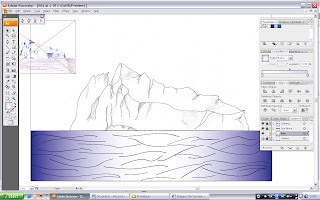
The sea have been done and it time to move on to the iceberg. I start off by create a new layer for the iceberg and draw the outline by the aid of the pen tool. I specially draw another straight line bellow the iceberg. This will ease me when I want to paint the iceberg white in the later procedure.
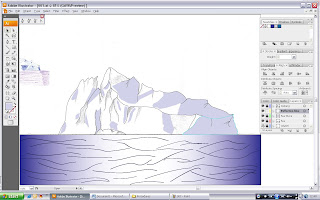 As the ice berg is being shine by the sun and sea just bellow the iceberg, there will be reflection of white, blue and even deeper blue. So, I create a new layer that is specially for illustrating the reflection of blue. I draw the reflection with the pen tool and with the setting of the stroke is set to none that will not show any outline. I also choose a new swatches colour that I set the name to reflection blue as the fill colour. Then, I illustrate according to my reference sketch.
As the ice berg is being shine by the sun and sea just bellow the iceberg, there will be reflection of white, blue and even deeper blue. So, I create a new layer that is specially for illustrating the reflection of blue. I draw the reflection with the pen tool and with the setting of the stroke is set to none that will not show any outline. I also choose a new swatches colour that I set the name to reflection blue as the fill colour. Then, I illustrate according to my reference sketch.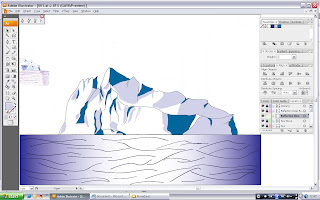
With the same procedures of the no. 6, I illustrate the deep blue reflection of sea with reference of the sketch.
 After that, I lock every layer except the iceberg layer. Then, I create a new layer on top of the sea wave layer and name it Iceberg (White) which it is to fill in the white colour that as the main colour of it. I select the iceberg layer and drag the selection tool around the iceberg and copy it. After it is copy, I select the iceberg (White) layer and paste it. The copy of the iceberg outline sure will be out from the main. I slowly drag it to match it to the original outline. With the outline match, I group it and paint it with live paint tool. I select the swatches that I rename it iceberg.
After that, I lock every layer except the iceberg layer. Then, I create a new layer on top of the sea wave layer and name it Iceberg (White) which it is to fill in the white colour that as the main colour of it. I select the iceberg layer and drag the selection tool around the iceberg and copy it. After it is copy, I select the iceberg (White) layer and paste it. The copy of the iceberg outline sure will be out from the main. I slowly drag it to match it to the original outline. With the outline match, I group it and paint it with live paint tool. I select the swatches that I rename it iceberg.
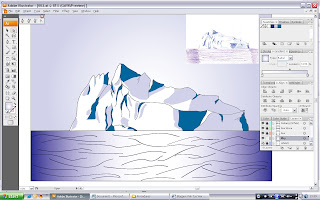
 After that, I lock every layer except the iceberg layer. Then, I create a new layer on top of the sea wave layer and name it Iceberg (White) which it is to fill in the white colour that as the main colour of it. I select the iceberg layer and drag the selection tool around the iceberg and copy it. After it is copy, I select the iceberg (White) layer and paste it. The copy of the iceberg outline sure will be out from the main. I slowly drag it to match it to the original outline. With the outline match, I group it and paint it with live paint tool. I select the swatches that I rename it iceberg.
After that, I lock every layer except the iceberg layer. Then, I create a new layer on top of the sea wave layer and name it Iceberg (White) which it is to fill in the white colour that as the main colour of it. I select the iceberg layer and drag the selection tool around the iceberg and copy it. After it is copy, I select the iceberg (White) layer and paste it. The copy of the iceberg outline sure will be out from the main. I slowly drag it to match it to the original outline. With the outline match, I group it and paint it with live paint tool. I select the swatches that I rename it iceberg.
After everything is done, I feel that the sky is kinda boring as it is white only. So, I create a new layer on top of sketch layer and name it Sky. I click the pen tool and draw around the border of the whole A3 size and select the stroke to none while the fill with gradient. As the blue is part of the reflection, I used it as the sky colour which suit the whole illustration. I chose the type gradient from linear to radial as to represent the sun behind the iceberg and drag the swatches colour of reflection blue to the gradient.
Friday, August 15, 2008
Add on the Colour
Sketch for assignment 2
Here are some of the sketch that I do for assignment 2.

This the first sketch that I do, but it was a failure deu to my iceberg that reach the sky as in the research that I do, it told me that teh submit would not be able to reach the sky.
Finally, I drawn out the thrid one that I am really satisfice with it detail. Therefore, I choose this sketch as my base of my design.

This the first sketch that I do, but it was a failure deu to my iceberg that reach the sky as in the research that I do, it told me that teh submit would not be able to reach the sky.

Well, after the first failure, I do a second draft of the iceberg. With luck it look much better but the richness of detail aren't very convincing. 

Finally, I drawn out the thrid one that I am really satisfice with it detail. Therefore, I choose this sketch as my base of my design.
Thursday, August 14, 2008
Reference Picture of iceberg
Through the help of search engine of Yahoo! and Google, I was able to found some of the iceberg picture that might help me in my illustration.

































Research about iceberg
(1) Introduction of iceberg
An Iceberg is a large piece of freshwater ice that has broken off from a snow-formed glacier or ice shelf and is floating in open water.
Only one-tenth of the volume of an iceberg is above water as due to the different of the density between the iceberg and the sea.. The shape of the remainder under the water can be difficult to surmise from looking at what is visible above the surface. This has led to the expression “tip of the iceberg”, generally applied to a problem or difficulty, meaning that the visible trouble is only a small manifestation of a larger problem.
Shape
In addition to the above size classification, there is also a type of classification based on shape. Two basic types of iceberg forms are tabular and non-tabular. Tabular icebergs have steep sides and a flat top, much like a plateau, with a length-to-height ratio of more than 5:1. Non-tabular icebergs have different shapes, and include
Dome: An iceberg with a rounded top.
Pinnacle: An iceberg with one or more spires.
Wedge: An iceberg with a steep edge on one side and a slope on the opposite side.
Dry-Dock: An iceberg that has eroded to form a slot or channel.
Blocky: An iceberg with steep, vertical sides and a flat top. It differs from tabular icebergs in that its shape is more like a block than a flat sheet.
Link: http://en.wikipedia.org/wiki/Iceberg
(2) Introduction of iceberg
Glaciers “flow” or “creep” outward under their own weight like a viscous fluid. When the edge of a glacier advances into the ocean the pieces that break off are what we call icebergs.
Icebergs are comprised of pure fresh water.
The term “iceberg” most likely originates from the Dutch term “ijsberg”, which means ice mountain.
The Glaciers of western Greenland, where 90% of Newfoundland’s icebergs originate, are amongst the fastest moving in the world, up to seven kilometres per year.
As icebergs drift south in the Labrador Current they enter Iceberg Alley, which extends south along the coast of Newfoundland. It takes approximately two or three years for these massive icebergs reach Newfoundland covering a distance of 1,600 nautical miles.
The icebergs that reach the east coast of Newfoundland probably calved from a glacier more than a year before.
When an iceberg does happen to reach the Atlantic Ocean its long and travelled life quickly comes to an end since it melts rapidly in the warm waters.
Between 10,000 to 15,000 icebergs are calves each year.
Link: http://www.canadiangeographic.ca/magazine/MA06/indepth/justthefacts.asp
(3) Introduction of iceberg
Where do icebergs come from?
A majority of the icebergs in the North Atlantic come from about 100 iceberg producing glaciers along the Greenland coast while a few originate in the Eastern Canadian Arctic Islands. The glaciers of western Greenland, where 90% of Newfoundland's icebergs originate, are amongst the fastest moving in the world, up to 7 km per year. The icebergs we see off Newfoundland are carried south in the cold Labrador current.
How many icebergs are there?
Approximately 40,000 medium to large sized icebergs calve annually in Greenland and about 1 to 2% (400-800) of those make it as far south as 48o north latitude (St. John's). The numbers vary greatly from year to year and seasonally as most are seen off Newfoundland in the spring and early summer.
How old are icebergs?
The icebergs that reach the east coast of Newfoundland probably calved from a glacier more than a year before. They often spend a year or more in cold arctic bays melting slowly (or not at all in winter) until eventually passing through the Davis Strait and into the Labrador current. Rarely do icebergs last more than one year south of this point. The glacial ice that icebergs are made of may be more that 15,000 years old!
How do icebergs form?
Glaciers form on land as a result of a net accumulation of snow over thousands of years. Successive layers compress earlier accumulations until, at depths below 60 to 70 meters, glacial ice is formed. Glaciers "flow" or "creep" outward under their own weight like a viscous fluid. When the edge of a glacier advances into the ocean the pieces that break off are what we call icebergs.
How fast do icebergs move?
The average drift speed of icebergs off the north east coast of Newfoundland is around 0.2 m/s (0.7km/h). Iceberg drift speed is actually influenced by many factors including iceberg size and shape, currents, waves and wind. Speeds greater than 1 m/s (3.6 km/h) have been observed, as have stationary non-grounded bergs. Icebergs often take quite eccentric paths so that the distance travelled by a berg may be two or three times the straight line distance over a week or so.
Where do icebergs go?
Before some icebergs completely deteriorate they may travel many thousands of kilometers. Originating at around 75o north latitude in Baffin Bay, an iceberg may travel up to 4,000 km south to around 40° north latitude (800 km south of St. John's). Extremely unusual sightings in Bermuda and Ireland have occurred well outside of this normal limit.
Why are icebergs mostly white?
Icebergs are mostly white because the ice is full of tiny air bubbles. The bubble surfaces reflect white light giving the iceberg an overall white appearance. Ice that is bubble free has a blue tint which is due to the same light phenomenon that tints the sky.
What causes streaks and colours in icebergs?
The blueish streaks of clear, bubble free ice often seen in icebergs results from the refreezing of meltwater which fills crevasses formed in the glacier as it creeps over land. The ice is blue because of the natural light scattering characteristics of pure ice. Occasionally airborne dust or dirt eroded from land ends up on the glacier surface eventually forming a noticeably darkened brown or black layer (in any orientation) within the ice of a floating iceberg.
How much of an iceberg is below water?
The "tip of the iceberg" expression can be explained as follows: Icebergs float because the density of ice (around 900 kg per cubic meter) is lower than that of seawater (around 1025 kg per cubic meter). The ratio of these densities tells us that 7/8 of the iceberg's mass must be below water. Usually icebergs are 20% to 30% longer under the water than above and not quite as deep as they are long at the waterline.
How do icebergs break up?
Simply put, icebergs melt. In the process they often calve and fracture into many pieces which can create trails or halos of smaller floating pieces. Usually icebergs melt the fastest at the waterline by the action of waves . The Waterline "notch" which forms induces calving of overhanging and submerged blocks. Melt and breakup rates change with water and at temperature. For instance a large berg may take 90 days to fully deteriorate in water temperatures around 0o whereas the same berg may only last 11 days in 10o water.
How much do icebergs weigh?
Icebergs off the coast of Newfoundland and Labrador range in size from massive tabular and blocky bergs in excess of several million tonnes to small bergs weighing 1% of this. Categories of iceberg sizes which are used for recording iceberg statistics range from very large (greater than 10 million tonnes and hundreds of meters long) to large, medium and small bergs and on to bergy bits then growlers, which are grand piano size pieces. Note that the average iceberg weight for the Grand Banks area is one to two hundred thousand tonnes, and is about the size of a cubic 15 storey building.
How cold are icebergs?
The interior temperature of icebergs off the coast of Newfoundland and Labrador is in the range of -15o to -20o C. Only at the surface does the temperature increase to 0o C (the melting point). Oddly, icebergs in warm water appear colder than those in cold water because the fast melting steepens the internal temperature gradient exposing the cold interior.
What shapes do icebergs come in?
A fantastic variety of shapes result from the deterioration process of icebergs. Despite the fact that no two icebergs are the same, there are certain categories of shapes that are used for iceberg observation. Often the terms; tabular, blocky, wedge, dome, pinnacle, and drydock are used.
What should I watch for when looking at an iceberg?
For those who wish to look beyond the beauty of icebergs there are many things to look for which can make iceberg watching more interesting. Besides estimating the iceberg's size and shape there are many features which may be noted. Coloured streaks, caves and tunnels, old and new waterline notches, even objects such as boulders or birds are seen on icebergs. Even more spectacular is the occasion of an iceberg calving and rolling which can often be heard from a good distance. An observers checklist is included with this website.
How close can you get to an iceberg?
It is dangerous to approach an iceberg because it can calve or roll creating a huge disturbance in the water which can upset a boat. There is no rule for safe space because certain icebergs may have long underwater rams which pose an even greater threat to an unwary vessel. Usually a minimum distance of the iceberg length should be kept though at this distance safety cannot be guaranteed. It is even more dangerous to attempt to get on an iceberg. Falling ice is a threat and a rolling berg can dump you in the very cold water before collapsing over on top of you.
Can you tow an iceberg?
Towing icebergs was first demonstrated in 1971 in Newfoundland. It is now a common practice in the management of icebergs for the offshore oil industry. Towing may not be the best term however, as often massive icebergs are merely deflected slightly from their paths. The tow is arranged by a vessel navigating around a berg while paying out a floating tow line. A junction is made so that the berg is lasooed and then tow tension is applied carefully to avoid rolling the berg or pulling the line over the top.
What is the largest iceberg recorded?
The largest Northern Hemisphere iceberg on record was encountered near Baffin Island in 1882. It was 13 km long, 6 km wide and had a freeboard (height above water) of about 20 m. The mass of that iceberg was in excess of 9 billion tonnes - enough water for everyone, in the world to drink a litre a day for over 4 years. Despite this staggering statistic, icebergs from Antarctica may be many times larger than this. In 1987 an iceberg with an area of 6350 square kilometers broke from the Ross ice shelf. That berg had a mass of around 1.4 trillion tonnes and could have supplied everyone in the world with 240 tonnes of pure drinking water.
How pure is iceberg ice?
Since glacier ice is formed from falling snow and snow results from condensed water vapor in the atmosphere, the water from icebergs is quite pure. Sometimes airborne dust from volcanic eruptions or from the wind (thousands of years ago) is deposited on the surface of a glacier and gradually becomes trapped within the ice so that traces are found in icebergs. But there are not likely to be many pollutants!
Are icebergs unstable?
Often icebergs are very unstable. The highly random shape and non-uniform melting and breakup of an iceberg leads to frequent shifts in orientation. Tabular bergs are generally the most stable whereas domed and wedge shaped bergs may roll completely over in seconds without any apparent provocation.
How hard is iceberg ice?
The crushing strength of ice is around 1% that of steel or 10% that of concrete. Though this may not sound very hard, a ship collision with an iceberg would surely end in disaster. The enormous momentum involved and potentially huge contact area with the ice can generate hundreds of tonnes of force on the hull which would cause it to dent and crumple.
Do icebergs hit the bottom?
Yes. Icebergs often "ground" or contact the seabed and get stuck. This is a frequent occurrence along the coast where icebergs are brought into shore by irregular tidal currents or strong winds. Sometimes icebergs "scour" the seabed creating irregular troughs that may be several kilometers in length. The edges of the Grand Banks are criss-crossed with old and new iceberg scour marks.
Are icebergs salty?
No. Icebergs are comprised of pure fresh water. There may be some dust embedded in the ice and salt water may be on the surface but it does not penetrate the ice. Iceberg ice is quite safe to consume.
Does iceberg ice last longer than fresh ice?
In short, the answer is no. When a piece of iceberg ice and a piece of freshwater ice are the same size, shape and temperature they will melt at around the some rate. A small experiment in which this was demonstrated actually showed that a block of tap water ice outlasted a similar iceberg ice block by 10 minutes over 30 hours.
Link: http://www.wordplay.com/tourism/icebergs/
An Iceberg is a large piece of freshwater ice that has broken off from a snow-formed glacier or ice shelf and is floating in open water.
Only one-tenth of the volume of an iceberg is above water as due to the different of the density between the iceberg and the sea.. The shape of the remainder under the water can be difficult to surmise from looking at what is visible above the surface. This has led to the expression “tip of the iceberg”, generally applied to a problem or difficulty, meaning that the visible trouble is only a small manifestation of a larger problem.
Shape
In addition to the above size classification, there is also a type of classification based on shape. Two basic types of iceberg forms are tabular and non-tabular. Tabular icebergs have steep sides and a flat top, much like a plateau, with a length-to-height ratio of more than 5:1. Non-tabular icebergs have different shapes, and include
Dome: An iceberg with a rounded top.
Pinnacle: An iceberg with one or more spires.
Wedge: An iceberg with a steep edge on one side and a slope on the opposite side.
Dry-Dock: An iceberg that has eroded to form a slot or channel.
Blocky: An iceberg with steep, vertical sides and a flat top. It differs from tabular icebergs in that its shape is more like a block than a flat sheet.
Link: http://en.wikipedia.org/wiki/Iceberg
(2) Introduction of iceberg
Glaciers “flow” or “creep” outward under their own weight like a viscous fluid. When the edge of a glacier advances into the ocean the pieces that break off are what we call icebergs.
Icebergs are comprised of pure fresh water.
The term “iceberg” most likely originates from the Dutch term “ijsberg”, which means ice mountain.
The Glaciers of western Greenland, where 90% of Newfoundland’s icebergs originate, are amongst the fastest moving in the world, up to seven kilometres per year.
As icebergs drift south in the Labrador Current they enter Iceberg Alley, which extends south along the coast of Newfoundland. It takes approximately two or three years for these massive icebergs reach Newfoundland covering a distance of 1,600 nautical miles.
The icebergs that reach the east coast of Newfoundland probably calved from a glacier more than a year before.
When an iceberg does happen to reach the Atlantic Ocean its long and travelled life quickly comes to an end since it melts rapidly in the warm waters.
Between 10,000 to 15,000 icebergs are calves each year.
Link: http://www.canadiangeographic.ca/magazine/MA06/indepth/justthefacts.asp
(3) Introduction of iceberg
Where do icebergs come from?
A majority of the icebergs in the North Atlantic come from about 100 iceberg producing glaciers along the Greenland coast while a few originate in the Eastern Canadian Arctic Islands. The glaciers of western Greenland, where 90% of Newfoundland's icebergs originate, are amongst the fastest moving in the world, up to 7 km per year. The icebergs we see off Newfoundland are carried south in the cold Labrador current.
How many icebergs are there?
Approximately 40,000 medium to large sized icebergs calve annually in Greenland and about 1 to 2% (400-800) of those make it as far south as 48o north latitude (St. John's). The numbers vary greatly from year to year and seasonally as most are seen off Newfoundland in the spring and early summer.
How old are icebergs?
The icebergs that reach the east coast of Newfoundland probably calved from a glacier more than a year before. They often spend a year or more in cold arctic bays melting slowly (or not at all in winter) until eventually passing through the Davis Strait and into the Labrador current. Rarely do icebergs last more than one year south of this point. The glacial ice that icebergs are made of may be more that 15,000 years old!
How do icebergs form?
Glaciers form on land as a result of a net accumulation of snow over thousands of years. Successive layers compress earlier accumulations until, at depths below 60 to 70 meters, glacial ice is formed. Glaciers "flow" or "creep" outward under their own weight like a viscous fluid. When the edge of a glacier advances into the ocean the pieces that break off are what we call icebergs.
How fast do icebergs move?
The average drift speed of icebergs off the north east coast of Newfoundland is around 0.2 m/s (0.7km/h). Iceberg drift speed is actually influenced by many factors including iceberg size and shape, currents, waves and wind. Speeds greater than 1 m/s (3.6 km/h) have been observed, as have stationary non-grounded bergs. Icebergs often take quite eccentric paths so that the distance travelled by a berg may be two or three times the straight line distance over a week or so.
Where do icebergs go?
Before some icebergs completely deteriorate they may travel many thousands of kilometers. Originating at around 75o north latitude in Baffin Bay, an iceberg may travel up to 4,000 km south to around 40° north latitude (800 km south of St. John's). Extremely unusual sightings in Bermuda and Ireland have occurred well outside of this normal limit.
Why are icebergs mostly white?
Icebergs are mostly white because the ice is full of tiny air bubbles. The bubble surfaces reflect white light giving the iceberg an overall white appearance. Ice that is bubble free has a blue tint which is due to the same light phenomenon that tints the sky.
What causes streaks and colours in icebergs?
The blueish streaks of clear, bubble free ice often seen in icebergs results from the refreezing of meltwater which fills crevasses formed in the glacier as it creeps over land. The ice is blue because of the natural light scattering characteristics of pure ice. Occasionally airborne dust or dirt eroded from land ends up on the glacier surface eventually forming a noticeably darkened brown or black layer (in any orientation) within the ice of a floating iceberg.
How much of an iceberg is below water?
The "tip of the iceberg" expression can be explained as follows: Icebergs float because the density of ice (around 900 kg per cubic meter) is lower than that of seawater (around 1025 kg per cubic meter). The ratio of these densities tells us that 7/8 of the iceberg's mass must be below water. Usually icebergs are 20% to 30% longer under the water than above and not quite as deep as they are long at the waterline.
How do icebergs break up?
Simply put, icebergs melt. In the process they often calve and fracture into many pieces which can create trails or halos of smaller floating pieces. Usually icebergs melt the fastest at the waterline by the action of waves . The Waterline "notch" which forms induces calving of overhanging and submerged blocks. Melt and breakup rates change with water and at temperature. For instance a large berg may take 90 days to fully deteriorate in water temperatures around 0o whereas the same berg may only last 11 days in 10o water.
How much do icebergs weigh?
Icebergs off the coast of Newfoundland and Labrador range in size from massive tabular and blocky bergs in excess of several million tonnes to small bergs weighing 1% of this. Categories of iceberg sizes which are used for recording iceberg statistics range from very large (greater than 10 million tonnes and hundreds of meters long) to large, medium and small bergs and on to bergy bits then growlers, which are grand piano size pieces. Note that the average iceberg weight for the Grand Banks area is one to two hundred thousand tonnes, and is about the size of a cubic 15 storey building.
How cold are icebergs?
The interior temperature of icebergs off the coast of Newfoundland and Labrador is in the range of -15o to -20o C. Only at the surface does the temperature increase to 0o C (the melting point). Oddly, icebergs in warm water appear colder than those in cold water because the fast melting steepens the internal temperature gradient exposing the cold interior.
What shapes do icebergs come in?
A fantastic variety of shapes result from the deterioration process of icebergs. Despite the fact that no two icebergs are the same, there are certain categories of shapes that are used for iceberg observation. Often the terms; tabular, blocky, wedge, dome, pinnacle, and drydock are used.
What should I watch for when looking at an iceberg?
For those who wish to look beyond the beauty of icebergs there are many things to look for which can make iceberg watching more interesting. Besides estimating the iceberg's size and shape there are many features which may be noted. Coloured streaks, caves and tunnels, old and new waterline notches, even objects such as boulders or birds are seen on icebergs. Even more spectacular is the occasion of an iceberg calving and rolling which can often be heard from a good distance. An observers checklist is included with this website.
How close can you get to an iceberg?
It is dangerous to approach an iceberg because it can calve or roll creating a huge disturbance in the water which can upset a boat. There is no rule for safe space because certain icebergs may have long underwater rams which pose an even greater threat to an unwary vessel. Usually a minimum distance of the iceberg length should be kept though at this distance safety cannot be guaranteed. It is even more dangerous to attempt to get on an iceberg. Falling ice is a threat and a rolling berg can dump you in the very cold water before collapsing over on top of you.
Can you tow an iceberg?
Towing icebergs was first demonstrated in 1971 in Newfoundland. It is now a common practice in the management of icebergs for the offshore oil industry. Towing may not be the best term however, as often massive icebergs are merely deflected slightly from their paths. The tow is arranged by a vessel navigating around a berg while paying out a floating tow line. A junction is made so that the berg is lasooed and then tow tension is applied carefully to avoid rolling the berg or pulling the line over the top.
What is the largest iceberg recorded?
The largest Northern Hemisphere iceberg on record was encountered near Baffin Island in 1882. It was 13 km long, 6 km wide and had a freeboard (height above water) of about 20 m. The mass of that iceberg was in excess of 9 billion tonnes - enough water for everyone, in the world to drink a litre a day for over 4 years. Despite this staggering statistic, icebergs from Antarctica may be many times larger than this. In 1987 an iceberg with an area of 6350 square kilometers broke from the Ross ice shelf. That berg had a mass of around 1.4 trillion tonnes and could have supplied everyone in the world with 240 tonnes of pure drinking water.
How pure is iceberg ice?
Since glacier ice is formed from falling snow and snow results from condensed water vapor in the atmosphere, the water from icebergs is quite pure. Sometimes airborne dust from volcanic eruptions or from the wind (thousands of years ago) is deposited on the surface of a glacier and gradually becomes trapped within the ice so that traces are found in icebergs. But there are not likely to be many pollutants!
Are icebergs unstable?
Often icebergs are very unstable. The highly random shape and non-uniform melting and breakup of an iceberg leads to frequent shifts in orientation. Tabular bergs are generally the most stable whereas domed and wedge shaped bergs may roll completely over in seconds without any apparent provocation.
How hard is iceberg ice?
The crushing strength of ice is around 1% that of steel or 10% that of concrete. Though this may not sound very hard, a ship collision with an iceberg would surely end in disaster. The enormous momentum involved and potentially huge contact area with the ice can generate hundreds of tonnes of force on the hull which would cause it to dent and crumple.
Do icebergs hit the bottom?
Yes. Icebergs often "ground" or contact the seabed and get stuck. This is a frequent occurrence along the coast where icebergs are brought into shore by irregular tidal currents or strong winds. Sometimes icebergs "scour" the seabed creating irregular troughs that may be several kilometers in length. The edges of the Grand Banks are criss-crossed with old and new iceberg scour marks.
Are icebergs salty?
No. Icebergs are comprised of pure fresh water. There may be some dust embedded in the ice and salt water may be on the surface but it does not penetrate the ice. Iceberg ice is quite safe to consume.
Does iceberg ice last longer than fresh ice?
In short, the answer is no. When a piece of iceberg ice and a piece of freshwater ice are the same size, shape and temperature they will melt at around the some rate. A small experiment in which this was demonstrated actually showed that a block of tap water ice outlasted a similar iceberg ice block by 10 minutes over 30 hours.
Link: http://www.wordplay.com/tourism/icebergs/
Assignment 2
Alright!!! After the short mid term break, I think is time for me to move on with my assignment 2. This time on the assignment 2, we are given the task to create a illustration of area that I chosen. As I had chosen the area of melting of the ice caps, I will create a illustration of the iceberg as my assignment 2.
Subscribe to:
Posts (Atom)

